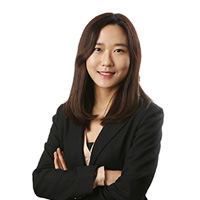S. Korea’s biz sentiment rebounds on hopes of easing restrictions
By Jung Min-kyungPublished : Sept. 29, 2021 - 15:29

South Korean businesses are beginning to paint a rosier outlook for the coming months with the government gearing up to treat COVID-19 more like seasonal influenza and to ease social distancing, a report from a think tank showed Wednesday.
The Korea Economic Research Institute’s forecast for next month’s business survey index of the country’s top 600 companies by sales showed the reading gained 2.8 points on-month to 103.4 for October.
A reading above 100 means optimists outnumber pessimists, while a figure below the benchmark means the opposite.
The outlook fell below 100 at 95.2 in August, with the fourth wave of the virus putting daily virus cases above 1,000 since early July, prompting the government to impose stricter social distancing rules.
The reading then recovered to 100.6 this month. Coupled with KERI’s latest forecast, it reflects the local businesses’ growing hopes of normalization, with the government envisioning the transition into “living with coronavirus.”
The nation’s health authorities said Tuesday that the new scheme would kick off around late October to early November when 80 percent of adults are likely to be fully vaccinated. Some 46 percent of the Korean population have been fully vaccinated so far, with 75 percent having received their first doses, as of Tuesday.
“Due to anticipations of gradual recovery into normalization through the ‘living with coronavirus’ scheme, the nonmanufacturing sector has displayed improvement in business sentiment,” the report read.
The nonmanufacturing sector, which includes the services industry, has been dealt the harshest blow from the pandemic, with social distancing rules limiting their opening hours and face-to-face contact with customers. The Bank of Korea on Wednesday said in its own report on the nation’s economy that the services sector in most areas across the country was hit by the resurgence of the virus in the third quarter, due to stricter social distancing and lackluster consumer spending.
Meanwhile, the manufacturing sector’s sentiment forecast for next month stood at 101 and above 100, also indicating optimism, but KERI highlighted concerns surrounding their overseas businesses, especially in Vietnam, affected by strict social distancing rules there.
“Due to Vietnam’s strict social distancing rules, manufacturers of clothing, shoes and original equipment manufacturers, where it provides parts to be used in products of another company, have been facing difficulties in manufacturing,” the report said.
Despite growing optimism, Choo Kwang-ho, the research head of KERI’s economy policy division, warned in the report that the surge in daily infections following the Sept. 20-22 Chuseok holiday this year could delay the new scheme, quickly dampening the business sentiment in turn. “The businesses’ financial condition and their profitability are not in such a great shape either, for the moment,” Choo added.
South Korea on Wednesday reported its second highest daily COVID-19 caseload on Wednesday, with 2,885 new patients confirmed in the previous 24 hours, pushing the total caseload to 308,725 since the start of the pandemic.
The Korea Economic Research Institute’s forecast for next month’s business survey index of the country’s top 600 companies by sales showed the reading gained 2.8 points on-month to 103.4 for October.
A reading above 100 means optimists outnumber pessimists, while a figure below the benchmark means the opposite.
The outlook fell below 100 at 95.2 in August, with the fourth wave of the virus putting daily virus cases above 1,000 since early July, prompting the government to impose stricter social distancing rules.
The reading then recovered to 100.6 this month. Coupled with KERI’s latest forecast, it reflects the local businesses’ growing hopes of normalization, with the government envisioning the transition into “living with coronavirus.”
The nation’s health authorities said Tuesday that the new scheme would kick off around late October to early November when 80 percent of adults are likely to be fully vaccinated. Some 46 percent of the Korean population have been fully vaccinated so far, with 75 percent having received their first doses, as of Tuesday.
“Due to anticipations of gradual recovery into normalization through the ‘living with coronavirus’ scheme, the nonmanufacturing sector has displayed improvement in business sentiment,” the report read.
The nonmanufacturing sector, which includes the services industry, has been dealt the harshest blow from the pandemic, with social distancing rules limiting their opening hours and face-to-face contact with customers. The Bank of Korea on Wednesday said in its own report on the nation’s economy that the services sector in most areas across the country was hit by the resurgence of the virus in the third quarter, due to stricter social distancing and lackluster consumer spending.
Meanwhile, the manufacturing sector’s sentiment forecast for next month stood at 101 and above 100, also indicating optimism, but KERI highlighted concerns surrounding their overseas businesses, especially in Vietnam, affected by strict social distancing rules there.
“Due to Vietnam’s strict social distancing rules, manufacturers of clothing, shoes and original equipment manufacturers, where it provides parts to be used in products of another company, have been facing difficulties in manufacturing,” the report said.
Despite growing optimism, Choo Kwang-ho, the research head of KERI’s economy policy division, warned in the report that the surge in daily infections following the Sept. 20-22 Chuseok holiday this year could delay the new scheme, quickly dampening the business sentiment in turn. “The businesses’ financial condition and their profitability are not in such a great shape either, for the moment,” Choo added.
South Korea on Wednesday reported its second highest daily COVID-19 caseload on Wednesday, with 2,885 new patients confirmed in the previous 24 hours, pushing the total caseload to 308,725 since the start of the pandemic.


















